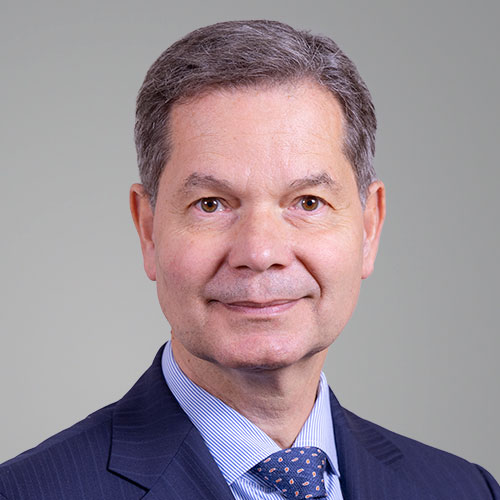2023 began with market optimism that the US could successfully navigate its battle with inflation. Recent data have confirmed our suspicions that getting inflation back to the Fed’s 2% target will be more challenging than markets had been assuming.
Key points
-
Indeed, developments in 2021-23 show similarities to the two disinflationary episodes during the 1965-82 Great Inflation (please see Ghosts of the 1970s, March, 2022 for more details).
-
On both occasions, policymakers moved aggressively to address inflationary pressures. However, with social strain building from rising unemployment, policymakers not only ended the rate hiking cycles amidst still persistent services/ wage inflation but also pivoted sharply cutting rates to support the economy and allow inflation to re-accelerate and become more deeply imbedded in the American economic fabric.
-
Worryingly, at the start of an emerging disinflationary period amidst the 21st century war against high inflation, markets are calling for a similar sharp pivot amidst still sticky wage/services inflation.
-
As a result, the Fed still likely faces its most important battle. Will it remain committed to winning the war against inflation and risk a deep recession or look instead to ease potential social costs that emerge via rising unemployment or financial system instability and allow inflation to become more deeply rooted in the economy?
-
We expect the Fed will remain committed which suggests that the elevated bond market volatility and shelter offered by alternative credit hedge fund strategies should persist until the Fed rate hiking cycle comes to an end.
The inflation battle: A long and drawn-out affair ahead
2023 began with market optimism that the US could successfully navigate its battle with inflation. Recent data have confirmed our suspicions that getting inflation back to the Fed’s 2% target will be more challenging than markets had been assuming.
At UBP, we continue to expect that US inflation will only fall to 3.5-4% by year-end 2023, above consensus expectations. Even with the 2023 consensus beginning to rise towards UBP forecasts, the prospect of a return to the 2-2.5% target set by the Federal Reserve remains firmly entrenched in market expectations for 2024.
While Fed success is certainly a potential scenario, learning from the policy choices made in the 1970s that prolonged the Great Inflation era offers investors an insight into how the next stages of the battle against inflation may unfold and what may be required to achieve the Fed’s objectives.
Recapping the 21st century’s battle with inflation
Two years into America’s 21st century battle against rising prices, the US central bank has rightly pivoted policy, embarking on the fastest tightening cycle since the Volcker rate hikes that eventually broke the Great Inflation of the era.
However, the 2023 attempt at moderating the pace of recent rate hikes highlights the challenge of implementing policy in an inflationary era.
It is worth remembering that the inflation challenges facing the US began in early-2021 with rising food and energy prices combined with escalating, supply-constrained goods prices leading the rebound in what was thought to be ‘transitory’ inflation.
By late-2021, ‘transitory’ inflationary pressures were joined by broader core inflationary pressures only to see another round of commodity price pressures emerge following Russia’s early-2022 invasion of Ukraine.
Looking more deeply into the widening of core inflationary pressure, investors saw inflation in the housing component - Shelter - accelerate with typically wage-driven services inflation following along behind.
It has been these core inflationary pressures that have renewed concerns among investors that disinflationary pressures may prove more faltering looking ahead and raised expectations of further interest rate hikes in recent weeks.
The Great Inflation (1965-82): ‘History never repeats itself but it often rhymes’1
Events of 2021-23 show similarities to two episodes during the 1965-82 Great Inflation – the first, following the 1973 Arab Oil Embargo and the second coming after 1979’s Iranian Revolution.
Then, like now, supply shocks drove commodity price inflation higher with services inflation mirroring the rise in the months that followed driven by the combination of rising housing costs and accelerating wages.
Given the prevalence of unionised workers in the 1970s with cost-of-living adjustments built into their contracts, the lagged pass through was not a surprise in retrospect. Indeed, even excluding the housing cost component, non-housing services inflation accelerated to 10-12% in 1974 and 1980 as wage costs flowed through.
Surprising many, in 2022, even without strong unions in the US and inflation-adjusted wage contracts, services inflation likewise followed the commodity and goods-driven inflation higher as the post-pandemic tightness in the labour market spurred wage increases in an effort to retain existing and hire new workers.
Looking back to the 1970s policy reaction function
While the inflationary parallels are clear, it is the disinflationary episodes of the Great Inflation era which are most instructive for investors looking ahead.
In 1973-74, the Fed raised rates alongside the acceleration in headline inflation. Its last rate hike came as food/energy price inflation peaked and unemployment rose while services inflation was still accelerating higher. With unemployment already beginning its rise, from 4.6% to 5.1% by the time the Fed ended its rate hikes, policymakers may have presumed that rising unemployment would be sufficient to end services price inflation looking forward.
The rate hiking cycle was aggressive enough to result in a continued rise in unemployment through 1975 to a peak of 9%. Housing-related services inflation eased from its peak in response, but non-housing services inflation proved stickier.
One likely factor driving the stickiness of overall services inflation was the immediate pivot to the 1974-75 easing cycle which reduced policy rates back to levels seen prior to the 1973 oil embargo.
The aftermath of the 1979 Iranian revolution saw a similar dynamic unfold. As commodity inflation peaked in early-1980, the Fed eased aggressively amidst a surge in unemployment from below 6% in 1979 to nearly 8% by mid-1980. This response to rising unemployment only allowed services linked inflation to trough at above 10% driven primarily by softness in the housing market while non-housing services inflation once again remained sticky settling only near 12% as the Fed began easing.
The abrupt shift to an easing stance, just like in 1974, allowed inflation to re-accelerate and required policy rates of nearly 20% in 1981 combined with the productivity gains of the IT revolution and expansion of the labour force (to include a greater share of women) finally to bring the Great Inflation era to an end.
On both occasions in the 1970s, policymakers rightly moved aggressively, though belatedly to address inflationary pressures. However, with social strain building from rising unemployment and a presumption that rising unemployment would be sufficient to end ongoing services price inflation, policymakers not only ended the rate hiking cycles amidst still persistent services/ wage inflation but pivoted sharply to cut rates in support of the economy on both occasions.
Markets anticipate a rapid pivot from rate hikes, like in the 1970s
Worryingly, the current disinflationary period amidst high inflation shows markets calling for a direct pivot from rate hikes to rate cuts as seen in 1974 and 1980.
Commodity and goods driven inflation are easing meaningfully from their mid-2022 peaks. However, now, like in the 1970s, services-driven inflation remains elevated averaging nearly 8% in recent months.
Even though housing-related services inflation has yet to peak, we expect it to do so with a lag in light of the dramatic weakening in housing market indicators since mid-2022. Non housing services inflation, however, has averaged over 7% in recent months.
Looking at wage data itself, Patrice Gautry, UBPs Chief Economist notes that private sector wages outside the leisure and hospitality sectors continue to accelerate, highlighting the persistence of wage and services-linked inflation.
Indeed, until the higher than expected inflation figures in January, markets were anticipating an end to Fed rate hikes as early as the 2nd quarter of 2023 with rate cuts expected to follow in the 2nd half, potentially replicating the reaction function of the Fed in the 1970s even without the social pressure from rising unemployment.
In light of signs of persistent inflation revealed in the January inflation report, futures markets have moved to price a higher peak in Fed policy rates in late-2023 but still to be followed once again by a rapid reduction in rates starting in early-2024. The events surrounding Silicon Valley Bank at mid-month, have not only unwound the hawkishness priced into markets in since February, but markets are now pricing an earlier end to rate hikes and a steeper rate cutting cycle than seen in January.
Somewhat reassuringly, the US Federal Reserve appears to have learned from the 1970s experience and instead of pivoting sharply, Fed communications, at least prior to the Silicon Valley Bank failure suggested they will keep raising rates to a sufficiently restrictive level (i.e., once non-housing related services inflation subsides) to restrain inflationary pressures and hold rates there for an extended period to ensure inflation’s demise.
While the Fed’s February commitment to draw on the lessons of the 1970s is encouraging, it still has to face its most important battle in its 21st century war against inflation. Social pressure will undoubtedly build if and when unemployment begins to rise, which the Fed’s own Summary of Economic Projections anticipates will take place later in 2023, or if banking system instability persists.
Should those projections be realised or should financial system stress spread, the Fed will face the difficult choice highlighted nearly one year ago in our Spotlight, Ghosts of the 1970s, March, 2022. The prospect of still elevated inflation combined with rising unemployment and market instability will present a stark choice to policymakers – remaining committed to winning the war against inflation and risk a deep recession or looking to ease potential social costs that emerge via rising unemployment and allow inflation to become more deeply rooted in the economy.
Policy rates continue to assume ongoing disinflation looking into year-end
For investors, the fact that Fed Chairman Jerome Powell has focused attention on services ex-shelter inflation provides further evidence that he and the policy-setting Federal Open Market Committee have learned the lessons from their 1970s predecessors.
So, with markets having consistently pushed back expectations for the end of Fed rate hikes in 2023, investors should look to developments on services ex-shelter inflation for signs that an end to the current hiking cycle is on the horizon.
Looking at the February, 2023 inflation report, services ex-shelter inflation reached 6.1% year-on-year. Encouragingly, removing the effects of Russia’s invasion of Ukraine in early-2022, on a 6-month annualised basis and a quarter-on-quarter basis, services ex-shelter inflation has begun to ease, but remains elevated at near 5% annualized.
Indeed, current levels of services ex-shelter inflation are still consistent with estimated levels seen at the ill-timed rate hike peak in 1974 as well as during the disinflationary 1980s.
Current policy rate expectations, in contrast, are more consistent with inflation returning to 3-3.5% as seen in the 1990s suggesting that investors will need to see services ex-shelter inflation ease further, perhaps to below the 4% level seen in the 1990s to avoid further upside surprises to policy rates ahead and a lay the foundation for a more durable end to Fed rate hikes later in 2023.
Look to alternative credit strategies to capitalise upon elevated bond market volatility
To date, short dated yields have borne the brunt of shifting expectations, with 3-month Treasury bill yields rising sharply while in contrast, longer dated 10-year Treasury yields have seen comparatively less pressure, actually falling 30 bps, leaving the 10-year / 3-month yield curve the most deeply inverted at more than -100 bps since the Great Inflation. However, further rises in policy rates need not necessarily put undue pressure on 10-year Treasury yields. During the 1970s and early-1980s, the 10-year / 3-month yield curve saw inversion of as much as 150-250 bps suggesting policy rates of 6-6.5% could still allow longer dated yields to stabilise near our 4-4.5% target range outlined in our 2023 Investment Outlook (please see Walking the Tightrope, November, 2022).
With yield curves so deeply inverted, investors can look to longer duration bonds as a way to position for an impending pause in Fed rate hikes and the prospect of recession on the horizon. Indeed, sharper declines in services ex-shelter inflation will likely serve as a key catalyst to drive a fall in longer dated yields and a shift lower in yields across the yield curve.
Until then, for investors, the lessons of the 1970s suggest that the elevated bond market volatility that has emerged since the start of the Fed tapering in late-2021 should persist until the Fed rate hiking cycle comes to an end.
Such volatility suggests that alternative credit strategies should continue to offer attractive risk-reward opportunities for investors as bond markets continue to reprice the evolving growth and inflation outlooks ahead.
With banking system instability having joined elevated inflation pressure, the challenges for the Federal Reserve to navigate a policy course that wins the war against inflation while still skirting an economic recession has become more treacherous. Lessons from the policy choices made in the 1970s combined with pro-active risk management should prove valuable for investors as they chart their own course ahead.











